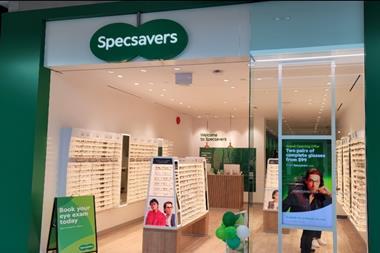Remember the last time you paid a visit to a jewellery store? The chances are that the answer is no, because this is a part of the retail spectrum that almost more than any other fits the term infrequent destination. It is unlikely that a shopper visiting a jewellery retailer has walked in by accident; therefore anyone coming though the door has to be taken seriously, because they are in the market for a relatively expensive item.
So it is a type of retailing where store environments matter. If a customer, even in the mass market, is seeking to buy something that will mark a special occasion, of whatever type, then the chances are they will want to be made to feel special. It is a trait that has long been recognised by modern independent jewellers whose store interiors often really do deserve the overused “cutting-edge” tag, a description frequently applied to any store that has a hint of glamour and/or design about it.
However, until recently, a visit to a jewellery store entailed being at the receiving end of a deeply conservative and predictable experience. The format was simple. Large numbers of staff stood poised and ready to welcome shoppers through the door and, in most cases, to walk back outside with a customer where the object of desire was pointed to in the arcade-style windows. Items would usually be displayed on shiny satin cushions and the sheer abundance of choice was intimidating in itself. Platinum or white gold band? Citizen or Omega-branded watch? Trays of merchandise would be removed from a window and a choice would then be made.
This form of selling was all about the breadth of offer, coupled with dark wood interiors, apricot-coloured walls and nondescript carpets – an interior format as typecast as it was dull. Fortunately, things have moved on, although there are still plenty of examples of old-style jewellery retailing around today.
Three weeks ago, jewellery giant Signet unveiled its latest answer to the problem of selling small, high-ticket items. The 1,175 sq ft (110 sq m) Ernest Jones store in Bluewater is one of six that are being tested in the run-up to Christmas. If it performs as expected, it should form the basis of a roll-out across the upscale Signet chain.
Ernest Jones is one of three fascias owned and operated by Signet in the Kentish megamall. About 100 metres along the lower level, opposite Marks & Spencer, is a branch of H Samuel and, if you head upstairs and keep walking away from Ernest Jones, you’ll stumble upon a branch of Leslie Davies, a Signet jewellery chain that is found only in the largest shopping developments.
Open season
While all three store designs are different in terms of what they sell and, to an extent, appearance, they do have a number of things in common. The most obvious is an open front. Signet investment relations director Tim Jackson says that this is a type of store design that Signet has borrowed from its US arm, where it operates a number of chains and is the largest jewellery retail group in the country.
The absence of windows and an uncluttered interior has been a focus more or less since the beginning of the decade and, perhaps unsurprisingly, the design is known as the “millennium” format at Ernest Jones, according to Jackson.
The Bluewater Ernest Jones is a move on from this again. Signet retained London design consultancy Irving at the start of the year to work on a new-look store that would place a greater emphasis on service and encourage more diamonds to be sold. “Diamonds are a very important part of the Ernest Jones business and, having reached the stage where we are in most of the retail centres we want to be in, moving the business forward has meant improving the stores that we have,” says Jackson.
And this is where the some of the other differences between Ernest Jones and H Samuel become apparent. The offers are targeted at quite distinct customer groups. The average selling price at H Samuel over the past year was£42, while Ernest Jones’s well-heeled clientele exited the stores with goods averaging£163. It is in the sales of diamonds that the differences are most stark. The average H Samuel diamond sale last year was worth£190, while at Ernest Jones it was£413.
The gulf in the average selling price between the two formats would lead you to expect that there would be a big difference in the way the stores look. But, until recently, the larger H Samuel chain had been improved internally to the point where Jackson admits that the difference was disappearing.
This is what Irving has been working on. Jackson says that the consultancy was given a number of objectives: to create the scope for a greater proportion of diamond sales, higher levels of service and a clear difference between H Samuel and Ernest Jones.
The result is a store with the characteristic Signet open-fronted mall look, but where the offer is very carefully segmented. Although shoppers may not be aware of it, the design guides customers to the sales assistant most likely to be able to help with an enquiry.
At first glance, the overriding impression is of a series of chromed metal and glass display cabinets. In the middle of the shop is a circular counter, to the left is a perimeter wall of branded watch displays and at the back of the shop stands a diamond counter and service desk.
Advice squad
Significantly, there is no dark wood and, although there is a relatively high level of ambient light, the focus is very much on the merchandise in the cabinets. Jackson says that stock densities are lower than in other branches and that, particularly in the diamond area, the emphasis is on advice and service, rather than an undifferentiated mass of glittering rings.
There are a substantial number of grey velvet and steel chairs placed around the shop and, in areas where greater amounts of service are required, more chairs have been provided.
The watch wall is also noteworthy. Organised by price, with the less expensive brands at the back leading up to the highly aspirational Breitling and Omega watches at the front, this is an exercise in allowing the merchandise collections to have their own character without anarchy being the result.
Above the display cases set around the perimeter of the shop, the watches’ brand logos have been set against a muted grey background, giving an impression of conformity. Each of the brands has been allowed its own coloured background within the display cases, but all have been given the same space and the signage is uniformly shaped and sized.
The result is a store interior that appears ordered and calm; just the kind of setting required for what Jackson says is a purchase where emotion will inevitably play a large part. The service counter even boasts a visitors’ book and, along with the paeans of praise for the level of service that shoppers have enjoyed, there is one entry that stands out: “Great refurbishment”.
Such a comment would be unusual at any store, but in the context of a shopping mall, it means that Signet’s new-look Ernest Jones experiment at Bluewater is likely to be seen in many other locations next year and beyond.


























No comments yet